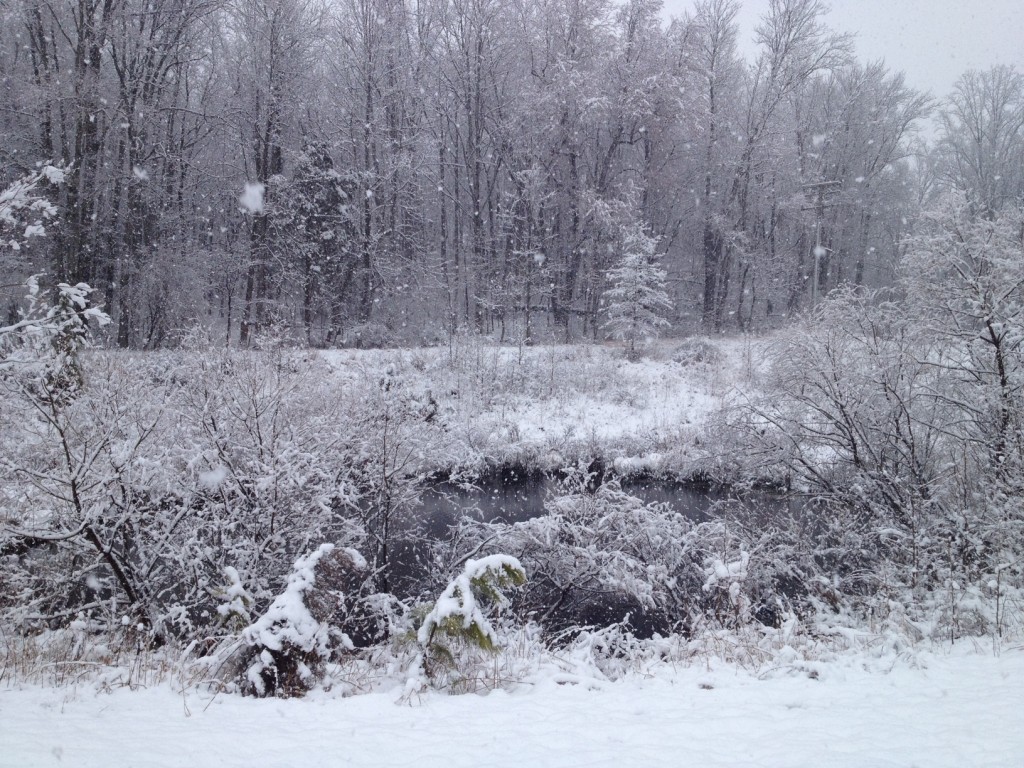by Kristen Minogue

SERC pond on the morning of March 25. The short-lived spring snowstorm dumped up to 6 inches throughout Maryland, but most of it melted within 24 hours. (Kristen Minogue)
If the massive snowstorms that pummeled the northeast this winter—and at least one downpour in spring—seem out of place in a warming world, climate scientists have a message: Don’t fret, it’s just physics.
For several years, scientists have anticipated a future of “less snow, more blizzards” in the winters ahead. The message may sound like a paradox. But for the planet, it boils down to one simple truth: Warm air holds more moisture than cold air.
Snowstorms occupy a narrow zone on the thermometer: To produce snow, the temperature has to be below freezing (32 °F). But the air also has to be warm enough to hold water—generally somewhere in the 20s. Monster snowstorms are much less likely to form with temperatures in the teens or lower. There isn’t enough moisture in the air to create snow in the first place.
This means that just a small upward nudge in temperature can turn a dry cold front into a blizzard. For each degree Celsius the temperature rises, the air is able to hold about 7 percent more water. And in the Northeast, winter temperatures are rising faster than summer temperatures. Since 1970 average winter temperatures went up 2°C (about 4°F)—twice as much as the average throughout the entire year, according to the U.S. Global Change Research Program. And they’re projected to rise another 2°C before the end of the century.
Scientists suspected this early as 2006, before the likes of Nemo and Snowmageddon buried the east coast. In a study tracking snowstorms over the entire 20th century, they discovered that throughout most of the U.S., 60 to 80 percent of the biggest snowstorms (6 inches or more) occurred in warmer-than-normal years. To the authors, the writing on the wall was clear: their findings suggested “a warmer future climate will generate more winter storms.”
Warmer winters equal more moisture. More moisture equals more intense snowstorms. But there’s still the issue of less snow overall. That is a little easier to explain.
As annual temperatures rise, winters don’t last as long. Spring is already arriving 10 days earlier in the Northern Hemisphere than it did in the 1950s. Spring snow cover has shrunk 1 million square miles over the last 45 years in the northern hemisphere, according to the Global Snow Lab at Rutgers University. Climate change is forcing snowstorms to work on an increasingly tight schedule. The blizzards that do fall are more severe, but it isn’t enough to make up for the lost time.
At some point, says Weather Underground director and meteorologist Jeff Masters, we may reach a threshold that’s too warm for heavy snowstorms. But for the next few decades, blizzards like the ones in 2013 and 2010 probably aren’t going anywhere.
More in Extreme Weather:
Land Hurricanes: The Science Behind the Derecho >>
Snowmageddon vs. Caribbean Creep >>
Hurrricanes, Snakeheads and Dead Zones: What 2011 Weather Meant for the Chesapeake >>


Global “Warming” like any pseudo-scientific theroy is completely malleable and its predictions are not binding. No matter what happens its proponents will credit the theroy for it.Here are a few examples:Prediction: Less snow leading to drought. Observation: massive blizzards contradicting prediction. Conclusion: Global “Warming” caused themPrediction: Antarctic Ice Pack will shrink causing sea rise. Observation: Antarctic Ice Pack is larger contradicting prediction. Conclusion: Global “Warming” caused itIt goes on and on and on.